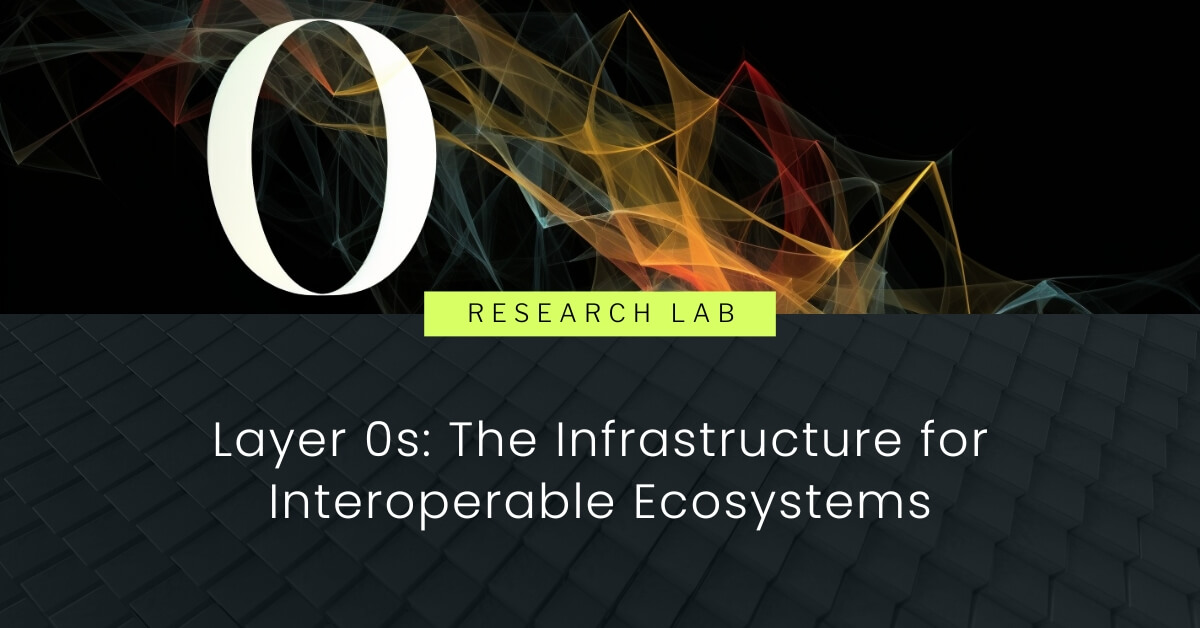Content
- What Are Layer 0s?
- How Do Layer 0s Work?
- How Cosmos Blockchain Works
- The Polkadot Blockchain
- Chainlink’s Cross Chain Interoperability Protocol (CCIP)
- Why are Layer 0s Necessary?
- Conclusion
- About Zerocap
- DISCLAIMER
- FAQs
- What are Layer 0s in the context of blockchain technology?
- How do Layer 0s enhance blockchain interoperability?
- What is the role of Software Development Kits (SDKs) in Layer 0s?
- How do Cosmos and Polkadot, the most prominent Layer 0s, function?
- Why are Layer 0s necessary for the growth of blockchain technology?
7 Apr, 23
Layer 0s: The Infrastructure for Interoperable Ecosystems

- What Are Layer 0s?
- How Do Layer 0s Work?
- How Cosmos Blockchain Works
- The Polkadot Blockchain
- Chainlink’s Cross Chain Interoperability Protocol (CCIP)
- Why are Layer 0s Necessary?
- Conclusion
- About Zerocap
- DISCLAIMER
- FAQs
- What are Layer 0s in the context of blockchain technology?
- How do Layer 0s enhance blockchain interoperability?
- What is the role of Software Development Kits (SDKs) in Layer 0s?
- How do Cosmos and Polkadot, the most prominent Layer 0s, function?
- Why are Layer 0s necessary for the growth of blockchain technology?
Presently, a blockchain ecosystem within which application-specific networks are the predominant model is feasible. At first glance this idea seems impractical or even ludicrous after all, how would each person share data or make transactions between separate layer blockchains? Enter layer 0s, a set of tools for creating layer 1s as a part of an interoperable ecosystem of blockchains. By weaving interoperability into their very fabric, layer 0s give rise to a swathe of new possibilities for the development of blockchain technology and the way in which users interact with it. This article will explore what layer 0s are, how they work and the innovations that they enable.

What Are Layer 0s?
As blockchain ecosystems continue to grow they are beginning to reach the limitations of their current infrastructure. Specifically, many layer 1s are suffering from scalability problems and those that do not typically sacrifice a degree of decentralisation or security as per the dictates of the blockchain trilemma. Furthermore, the current blockchain ecosystem is siloed; each layer 1 possesses its own native ecosystem with minimal composability or cooperation between them.
Addressing these problems are layer 0 networks, acting as the infrastructure for creating interoperable ecosystems of layer 1s. Furthermore, layer 0s often leverage software development kits (SDKs) that allow developers to quickly and simply launch a layer 1. In doing so, they enable the creation of customised blockchains operating within a wider interoperable ecosystem. These customised blockchains can then cater to a specific use case such as DeFi or a DeFi application without sacrificing the network effect. Presently, Cosmos and Polkadot, the most prominent layer 0s, host a number of application-specific blockchains.
The key benefit provided by layer 0s is seamless interoperability between layer 1s. Facilitated via inter-blockchain communication protocols, layer 0s allow for data to be sent and transactions to be executed between separate blockchains. This mechanism solves the lack of composability which exists between layer 1s presently and opens the floodgates of novel possibilities for the blockchain ecosystem.
Specifically, cross-chain composability enables greater layer 1 specialisation, allowing developers to build purpose-built and application-specific blockchains. By discarding specific functions necessary for the usability and functionality of a monolithic blockchain, the interoperable blockchain ecosystems built on layer 0s may fill more niches and operate with more efficiency than a monolithic blockchain. This would imply that layer 0s facilitate the growth of blockchain ecosystems that possess greater scalability and decentralisation than comparable ecosystems built on a layer 1.
How Do Layer 0s Work?
Layer 0 protocols differ in their implementation and features depending on their intended use case. Nevertheless, they share a certain basic structure, consisting of several components. These components include; a main chain that serves as the flagship layer 1 operating on the layer 0, a software development kit (SDK) designed to streamline the process of deploying layer 1s, the native ecosystem of layer 1s built on the layer 0 and the cross-chain communication protocol which enables interoperability, serving as the backbone of the ecosystem. Presently, Cosmos and Polkadot are the dominant layer 0s. Each has its own unique implementation of the technology.
How Cosmos Blockchain Works
Cosmos, as the name suggests, is aiming to create a network of blockchains they refer to as the internet of blockchains. To do so, the protocol uses four components, the Tendermint Byzantine Fault Tolerance consensus algorithm (BFT), the Cosmos Hub and its zones, the Inter-Blockchain Communication Protocol (IBC) and the Cosmos SDK. Together, these parts enable developers to create and deploy layer 1s into an interoperable ecosystem.
Tendermint BFT is an engine designed to facilitate consensus between participants in a network. The system works by having participants, referred to as validators, take turns proposing blocks and voting on them. Each time a block is committed a new validator gets to propose a new block. This consensus algorithm is referred to as delegated Proof of Stake (dPoS). This mechanism enables instant finality each time a block is committed. The entire process is exhibited in the diagram below:
By enabling this instant finality, Tendermint allows the network of blockchains connected to the IBC to stay in sync. This is because each time a new block is added to the chain, all participants in the network can be sure that the block is valid and that the state of the network has been updated accordingly. This prevents forks or divergent chains from forming, which can lead to data corruption, double-spending, and other problems. The importance of keeping the network of blockchains in sync cannot be overstated. Without this synchronisation, it would not be possible for different blockchain projects to communicate with each other and share data.
The Cosmos Hub was the first blockchain to be launched on the Cosmos network and acts as an intermediary between Cosmos zones. Each Cosmos zone is a separate layer 1 blockchain built on Cosmos. While each of these zones is able to carry out essential functions on its own, the Cosmos Hub facilitates interoperability between zones by keeping track of their states.
Communication between Cosmos zones is facilitated by the IBC. This protocol leverages the instant finality provided by Tendermint to transfer data between heterogeneous blockchains. The IBC is composed of two layers; the transport layer (IBC/TAO) defines standards for the Transport, Authentication and Ordering of data packets while the application layer (IBC/APP) defines standards for the application handlers of data packets. When an interchain transaction is initiated, data packets are sent via dedicated channels run on smart contract modules and secured by light clients which verify that the state sent by either party is valid. To gain a proper understanding of how the IBC relays data between blockchains, an example is beneficial:
Blockchain 1 initiates a cross-chain message, looking to send miscellaneous data to blockchain 2. Data packets are sent from blockchain 1’s dedicated channel via a relay layer to blockchain 2’s dedicated channel. The relay layer is responsible for transferring data between specified channels. Each channel consists of a smart contract connection at either end responsible for proving data was received from a particular sender. Once received by blockchain 2’s channel, the data is relayed to blockchain 2’s TAO module. The TAO module facilitates the order of operations, ensuring that the data is received properly. Once received, the data is authenticated by a light client operating on blockchain 2 in the order that it was sent by the TAO module. If the presented state of blockchain 1 is confirmed by the light client the data is validated and accepted by blockchain 2. This system enables the transfer of data and digital assets.
Lastly, the Cosmos SDK is a highly customisable modular framework, allowing developers to build blockchains employing Tendermint BFT and the IBC. It serves to greatly minimise the complexity associated with building blockchains by offering simple plugins for most of the common functionality contained within a layer 1, thereby allowing developers to focus on developing the niche aspects of their blockchain which cater to its intended use case. Developers write their own custom blockchain consisting of pre-built Cosmos modules and custom-designed modules, launch said blockchain and connect it to the IBC to enable interoperability within the Cosmos ecosystem.
The Polkadot Blockchain
Created by Ethereum co-founder, Gavin Wood, Polkadot has a similar vision to Cosmos, that being the development of an inter-blockchain network that allows layer 1s with different use cases to work together efficiently. The network is composed of four components. Polkadot’s relay chain acts as a governance layer responsible for validating data and achieving consensus. Existing atop Polkadot are the network’s parachains – the independent, yet interoperable layer 1s built on the layer 0’s infrastructure. Additionally, Polkadot comes with bridges and parathreads that connect blockchains and allow for data transfer as well as the final infrastructure layer, Substrate, Polkadot’s modular development framework.
The relay chain acts as a central coordinator that facilitates communication and transaction execution between parachains. It is responsible for maintaining the overall state of the network, including the validity of the parachains and their inter-chain transactions. Additionally, it manages the allocation of resources such as processing power, bandwidth, and storage to the parachains. The relay chain also acts as a central hub for security, ensuring that any malicious activities on the network can be detected and remedied.
Polkadot parachains are standalone blockchains that run in parallel to the Polkadot network. Each parachain can have its own state, consensus mechanism, transaction logic, and governance rules, specialised in supporting its intended use case. Parachains can be conceptualised as modules connected to the Polkadot ecosystem via the relay chain, being added or removed as needed, providing a high degree of flexibility to the network.
Polkadot’s cross-chain communication scheme allows for secure and seamless communication between parachains and the relay chain. It is facilitated by a mechanism referred to as Cross Chain Message Passing (XCMP). Within this scheme, messages are formatted as ‘parachain data headers’ which contains information regarding the origin and destination chains as well as the data being sent. This communication mechanism enables interoperability within the Polkadot ecosystem.
Lastly, Substrate is an SDK that enables developers to build and deploy their own blockchain applications on the Polkadot network. Built using the Rust programming language, Substrate offers a flexible framework with pre-built modules for consensus, governance, token management and more. Similarly to the Cosmos’ SDK, Substrate expedited the process of layer 1 development, enabling developers to focus on customising their layer 1s.
Chainlink’s Cross Chain Interoperability Protocol (CCIP)
Chainlink, a decentralised oracle network, has developed a cross-chain communication protocol that allows developers to easily connect their smart contracts to various blockchains in a permissionless manner. CCIP functions in a fundamentally different way from other Layer 0 protocols on the market; rather than providing an infrastructure for developers to build their own Layer 1’s atop, CCIP enables limitless communication between any blockchain without the need to be backwards compatible.
The CCIP itself operates on a three-layer stack. The first layer is a transport layer designed to enable fast and efficient messaging. The second layer is the CCIP itself, an open standard that blockchains can connect to send messages between blockchains. The third layer is the application layer which provides an environment for the deployment of real-world DApps. Additionally, the CCIP includes an anti-fraud network designed to detect and mitigate fraudulent activity. Working together, these layers facilitate efficient and secure cross-chain communication, allowing for the development of novel applications that leverage the resources of multiple networks.
Why are Layer 0s Necessary?
As mentioned earlier, the current blockchain ecosystem is siloed. Each monolithic layer 1 must provide the necessary structures for its entire ecosystem to function, decreasing efficiency. Specialised layer 1s are less efficient as they require the facilities to host the necessary financial structures to attract a large user base. Ultimately, without interoperability, the growth of the present blockchain landscape may be curtailed.
The advantage of Layer 0 networks is the added flexibility and interoperability they provide for developers and end users. With the ability to launch multiple layer 1 blockchains that can be tailored to specific needs, developers have more options for building and deploying their projects. Additionally, the ability to seamlessly connect and interact with other blockchains in the ecosystem results in continuous innovation and a stronger network effect on the layer 0s.
In doing so, layer 0s have the potential to transform the current blockchain landscape. By facilitating interoperability between layer 1s, it is possible to create a web3 ecosystem similar in nature to the web2 ecosystem being large, composable and diverse. As a result, the use cases and scale of blockchain technology may expand massively.
Conclusion
Layer 0s are the solution to creating an interoperable Web3 ecosystem, providing an avenue for seamless communication between layer 1s. While layer 0s differ greatly in their implementation, each operates using a cross-chain communication protocol. Cosmos and Polkadot exemplify this diversity of implementation, each utilising different methods to assist their native ecosystem while retaining a similar basic structure and core philosophy of connectivity. Consequently, layer 0s may enable the growth and diversification of blockchain technology, providing the roots for a connected ecosystem of layer 1s.
About Zerocap
Zerocap provides digital asset investment and digital asset custodial services to forward-thinking investors and institutions globally. For frictionless access to digital assets with industry-leading security, contact our team at [email protected] or visit our website www.zerocap.com
DISCLAIMER
Zerocap Pty Ltd carries out regulated and unregulated activities.
Spot crypto-asset services and products offered by Zerocap are not regulated by ASIC. Zerocap Pty Ltd is registered with AUSTRAC as a DCE (digital currency exchange) service provider (DCE100635539-001).
Regulated services and products include structured products (derivatives) and funds (managed investment schemes) are available to Wholesale Clients only as per Sections 761GA and 708(10) of the Corporations Act 2001 (Cth) (Sophisticated/Wholesale Client). To serve these products, Zerocap Pty Ltd is a Corporate Authorised Representative (CAR: 001289130) of AFSL 340799
All material in this website is intended for illustrative purposes and general information only. It does not constitute financial advice nor does it take into account your investment objectives, financial situation or particular needs. You should consider the information in light of your objectives, financial situation and needs before making any decision about whether to acquire or dispose of any digital asset. Investments in digital assets can be risky and you may lose your investment. Past performance is no indication of future performance.
FAQs
What are Layer 0s in the context of blockchain technology?
Layer 0s are the infrastructure for creating interoperable ecosystems of Layer 1 blockchains. They address the scalability problems and lack of composability between different Layer 1 blockchains. Layer 0s leverage software development kits (SDKs) that allow developers to quickly and simply launch a Layer 1, enabling the creation of customised blockchains operating within a wider interoperable ecosystem. The most prominent Layer 0s currently are Cosmos and Polkadot.
How do Layer 0s enhance blockchain interoperability?
Layer 0s enhance blockchain interoperability by facilitating data transfer and transaction execution between separate blockchains. This is achieved through inter-blockchain communication protocols. The key benefit provided by Layer 0s is seamless interoperability between Layer 1s, which solves the lack of composability existing between Layer 1s and opens up new possibilities for the blockchain ecosystem.
What is the role of Software Development Kits (SDKs) in Layer 0s?
SDKs in Layer 0s streamline the process of deploying Layer 1s. They allow developers to quickly and simply launch a Layer 1, enabling the creation of customised blockchains operating within a wider interoperable ecosystem. These customised blockchains can cater to a specific use case such as DeFi or a DeFi application without sacrificing the network effect.
How do Cosmos and Polkadot, the most prominent Layer 0s, function?
Cosmos uses components like the Tendermint Byzantine Fault Tolerance consensus algorithm, the Cosmos Hub and its zones, the Inter-Blockchain Communication Protocol (IBC), and the Cosmos SDK to create an interoperable ecosystem. Polkadot, created by Ethereum co-founder, Gavin Wood, uses its relay chain, parachains, bridges, parathreads, and Substrate to achieve a similar goal. Both have unique implementations of the technology but share a similar basic structure and core philosophy of connectivity.
Why are Layer 0s necessary for the growth of blockchain technology?
Layer 0s are necessary as they provide the solution to creating an interoperable Web3 ecosystem, providing an avenue for seamless communication between Layer 1s. They facilitate interoperability between Layer 1s, enabling the creation of a web3 ecosystem that is large, composable, and diverse. As a result, the use cases and scale of blockchain technology may expand massively.
Like this article? Share
Latest Insights
On-chain Bitcoin Metrics: The Main References
In the realm of cryptocurrency investment, on-chain Bitcoin metrics provide a critical lens through which investors can gauge market conditions and make informed decisions. These
What is the Base Blockchain? The Coinbase Layer 2
The Base blockchain, introduced by Coinbase, represents a significant development in the realm of cryptocurrency and blockchain technology. It is a layer-2 solution built on
Bitcoin Mining in the US: Main Challenges
Bitcoin mining in the United States has recently faced a range of challenges, from regulatory hurdles to community and environmental concerns. As a significant hub
Receive Our Insights
Subscribe to receive our publications in newsletter format — the best way to stay informed about crypto asset market trends and topics.



 Share
Share  Tweet
Tweet  Post
Post 